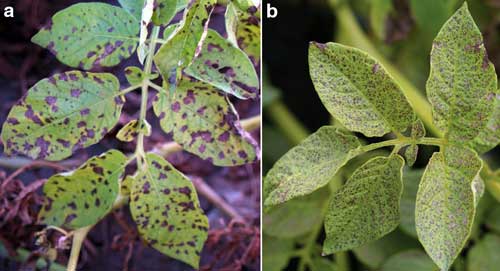Brown leaf spot in potatoes: Plan for this early blight look-alike in 2013
Brown leaf spot of potatoes can be misidentified as early blight, potentially compromising disease control.
Early blight, caused by Alternaria solani, is a very common fungal disease present in most regions that produce potatoes. Brown leaf spot (Alternaria alternata) of potatoes has gained attention recently for its similarity to early blight. Just as common, yet underestimated, brown leaf spot presents symptoms that are often incorrectly attributed to early blight. Successful control of both pathogens depends on accurate identification and a tailored approach.
Brown leaf spot
The fungus that causes brown leaf spot, Alternaria alternata, is closely related to early blight (Alternaria solani). Like early blight, brown leaf spot overwinters as spores and mycelia on the infected tissue of various Solanaceous hosts. Warmer temperatures in spring trigger fruiting and the release of spores from both fungi, which are moved by wind and water onto potato plants. When moisture is available, the spores germinate and penetrate potato tissue, often through existing wounds. Initial infections of the two pathogens create similar symptoms: small, dark spots on lower leaves.

(A) Symptoms
of early blight on potato leaves caused by Alternaria
solani and
(B) symptoms of brown leaf spot on potato leaves caused by Alternaria alternata.
Photo credit:
Willie Kirk and Phillip Wharton, MSU
However, the foliar lesions caused by brown leaf spot never develop the dark concentric rings characteristic of early blight. They coalesce across large veins until whole leaves turn brown and hang from the plant. The tuber symptoms of brown leaf spot are commonly referred to as black pit, appearing as small black holes in the tuber surface. Brown leaf spot can also result in skin patches similar to those caused by early blight, most often observed after washing.
Brown leaf spot can be managed using cultural controls and fungicides. Crop rotation including non-host crops and cultural practices such as the planting of certified seed, timely irrigation, and post-harvest refuse management should be the foundation of any disease management program. Fungicides can be applied after flowering to improve control. Strobilurins used for early blight will not provide adequate control of brown leaf spot. Yet, protectant fungicides also often prescribed for early blight (e.g., maneb, mancozeb, chlorothalonil and triphenyltin hydroxide) are moderately effective against brown leaf spot when applied at approximately seven- to10-day intervals. This highlights the point that strobilurin fungicides should always be paired with a protectant fungicide to manage pathogen diversity and pesticide resistance.
More information on brown leaf spot of potatoes can be found in a new bulletin from Michigan State University Extension and the Michigan Potato Industry Commission titled Michigan Potato Disease: Brown Leaf Spot (E3182). This bulletin and others are available free through the Michigan State University Extension Bookstore.
References
- Michigan Potato Disease: Brown Leaf Spot, MSU Extension Bulletin E3182
- Michigan Potato Disease: Early Blight, MSU Extension Bulletin E2991
Dr. Kirk's work is funded in part by MSU's AgBioResearch.



 Print
Print Email
Email
